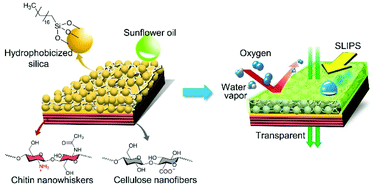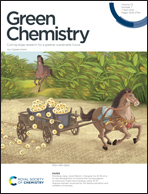Sustainable, self-cleaning, transparent, and moisture/oxygen-barrier coating films for food packaging†
Abstract
Plastic packaging effectively protects food from mechanical, microbial, and chemical damage; however, oxygen and moisture permeate these plastics and spoil the food. Thus, the gas barrier function is usually imparted through metallic or halogenated polymeric coatings. However, the former blocks visible light, while the latter causes environmental concerns. Moreover, plastic packaging contaminated with food scraps and stains requires a washing process for recycling. To satisfy the key requirements for food packaging, we fabricated a (1) sustainable, (2) self-cleaning, (3) transparent, and (4) oxygen/moisture barrier coating on poly(ethylene terephthalate) (PET) film. A spray-assisted layer-by-layer assembly of negatively charged cellulose nanofibers and positively charged chitosan nanowhiskers was coated on one side of the PET film. Salt bridge-mediated synergistic interplay between these highly crystalline nanomaterials imparted a low oxygen transmission rate of less than 0.1 mL m−2 day−1. The other side of the PET film was formed with a porous surface by spray-coating of silica nanoparticles and chitosan nanowhiskers. Thereafter, the porous surface was impregnated with bio-based sunflower oil. This side repelled the contaminants and exhibited a low water vapor transmission rate of 1.4 g m−2 day−1. The gas barrier performance meets the packaging requirements for most food products. This coating has high potential for sustainable packaging applications.



 Please wait while we load your content...
Please wait while we load your content...